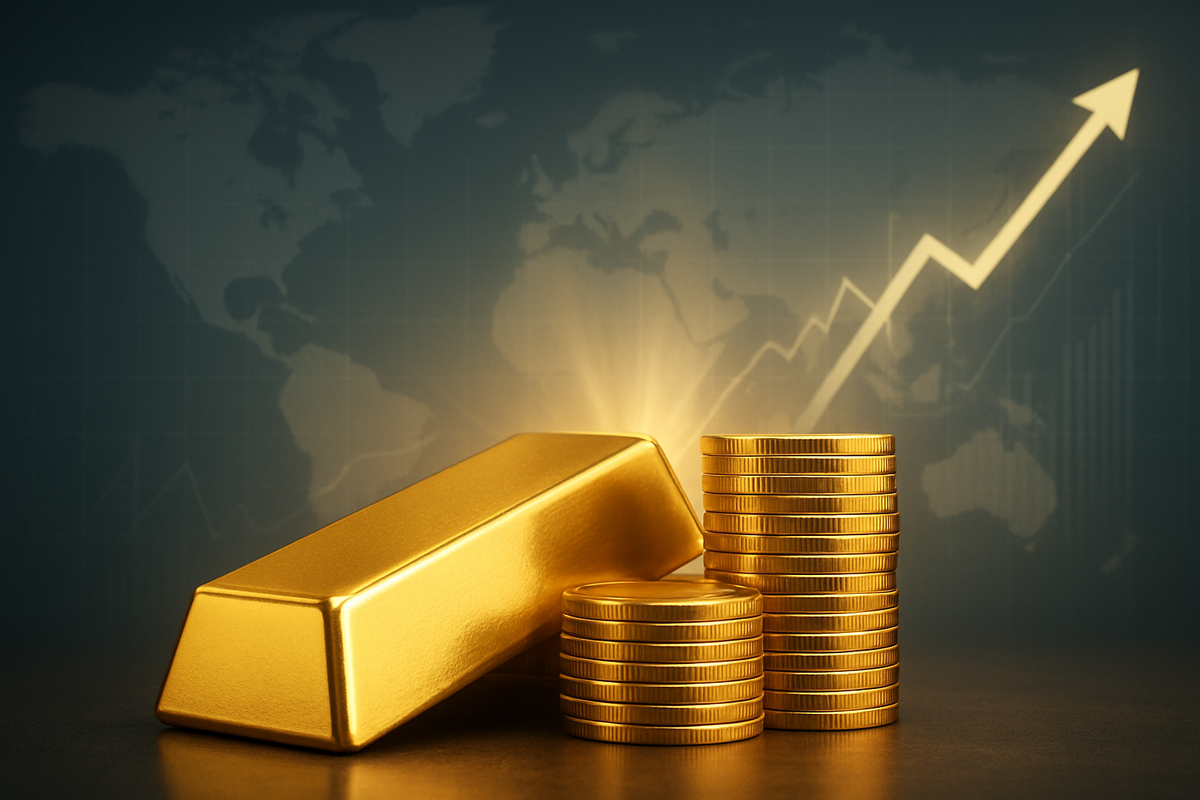
The World Bank has issued a striking forecast for gold prices, predicting a robust and sustained ascent through 2025 and into 2026. This bullish outlook, highlighted in its recent Commodity Markets Outlook reports, signals a significant shift in the precious metals market, positioning gold as a standout performer amidst a broader expected decline in other commodity prices. Investors and market watchers are now keenly assessing the implications of this sustained upward trajectory for the global financial landscape.
This projection suggests that gold is not merely experiencing a temporary rally but is entering a prolonged period of elevated value, driven by a confluence of powerful global factors. The immediate implication is a reinforcement of gold's traditional role as a safe-haven asset, prompting a re-evaluation of investment strategies and potentially drawing substantial capital into the precious metal, impacting everything from central bank reserves to individual investment portfolios.
Unpacking the Golden Prophecy: Details, Drivers, and Dynamics
The World Bank's latest projections, particularly from its October 2025 report, are nothing short of remarkable. Gold prices are now forecast to surge by an astonishing 42% in 2025 alone, building on an already strong performance in 2024, which saw a 21% rise. This momentum is expected to carry into 2026, with an additional 5% increase projected. This means gold prices are anticipated to remain approximately 150% above their 2015-2019 average through 2025-2026, potentially doubling that average by 2026. This sustained elevation stands in stark contrast to the World Bank's broader forecast for other commodity prices, which are generally expected to decline to a six-year low by 2026.
The timeline leading up to this moment has seen a consistent strengthening of gold's position. Earlier reports from October 2024 had already hinted at record-breaking prices, setting the stage for the current, even more aggressive, forecast. Key players driving this trend include global central banks, who have been accumulating gold at unprecedented rates, and a resurgent interest from institutional and retail investors, evidenced by strong inflows into gold-backed Exchange-Traded Funds (ETFs) in early 2025. These collective actions reflect a growing global consensus on gold's value as a hedge against pervasive uncertainties.
The primary drivers behind this bullish outlook are multifaceted. Escalating geopolitical tensions and pervasive global economic uncertainty are consistently cited as paramount, pushing investors towards gold as a reliable store of value. Furthermore, aggressive central bank purchases, driven by diversification strategies away from the U.S. dollar and concerns over geopolitical stability, are providing a strong demand floor. The anticipation of future interest rate cuts by the U.S. Federal Reserve and a potentially weaker dollar also contribute to gold's appeal, as lower rates typically reduce the opportunity cost of holding non-yielding assets like gold. Initial market reactions have been largely positive for gold, with analysts and investors increasingly factoring in a prolonged period of high prices.
A Golden Opportunity: Winners and Losers in the Market
The World Bank's forecast presents a clear delineation of potential winners and losers within the financial markets. Gold mining companies stand to be the primary beneficiaries, as higher gold prices directly translate to increased revenues and profitability. Major players like Barrick Gold (NYSE: GOLD), Newmont Corporation (NYSE: NEM), and AngloGold Ashanti (NYSE: AU) are poised for significant gains. These companies, with their extensive reserves and operational capacities, will see the value of their underlying assets appreciate, potentially leading to increased exploration budgets, higher dividends, and stronger stock performance. Junior mining companies and exploration firms may also find it easier to secure funding for new projects, invigorating the entire gold mining sector.
Conversely, industries and companies that rely on gold as a raw material, such as jewelry manufacturers and certain high-tech electronics firms, might face increased input costs. While some of these costs can be passed on to consumers, persistent high gold prices could squeeze profit margins or temper demand for luxury goods. Furthermore, investors heavily weighted in traditional financial assets might find their portfolios underperforming relative to those with significant gold exposure, particularly if the drivers of gold's rise (e.g., inflation, geopolitical instability) simultaneously depress other asset classes. Central banks, while benefiting from the increased value of their gold reserves, might also face challenges in managing currency stability if the U.S. dollar weakens significantly against gold.
Broader Implications: Trends, Policies, and Precedents
The World Bank's gold forecast is not an isolated event but fits squarely within several broader industry trends. It underscores a growing global appetite for diversification away from traditional fiat currencies, particularly the U.S. dollar, in an era of heightened geopolitical fragmentation and economic uncertainty. Central banks' sustained gold accumulation is a testament to this trend, reflecting a strategic shift in reserve management policies aimed at enhancing financial stability and reducing reliance on any single reserve currency. This could accelerate the de-dollarization trend observed in various economies.
The potential ripple effects extend to regulatory and monetary policy. If gold's rise is fueled by persistent inflation concerns, central banks globally might face increased pressure to maintain tighter monetary policies or find new tools to manage price stability. Conversely, if the Federal Reserve does indeed cut rates, as anticipated by some, it would further bolster gold's attractiveness. Historically, gold has served as a reliable hedge during periods of high inflation and geopolitical turmoil. Comparisons can be drawn to the 1970s, a decade marked by oil shocks, high inflation, and geopolitical instability, during which gold prices experienced a dramatic surge. The current environment, with its complex interplay of economic and geopolitical risks, mirrors some of these historical precedents, reinforcing gold's role as a crisis commodity.
The Road Ahead: Navigating a Golden Future
Looking ahead, the short-term and long-term possibilities for gold are largely dictated by the persistence of the underlying drivers. In the short term, continued geopolitical tensions, further central bank purchases, and any signs of sustained inflation or currency debasement will likely keep gold prices on an upward trajectory. The upcoming months will be crucial in observing how global economic policies evolve and how major central banks, particularly the Federal Reserve, navigate their monetary strategies.
For investors, this environment presents both opportunities and challenges. Opportunities lie in strategic allocations to physical gold, gold-backed ETFs, and shares of robust gold mining companies. However, challenges include managing volatility and assessing the precise timing of entries and exits, as even a "safe haven" asset can experience price fluctuations. Potential strategic pivots for institutions might include increasing their gold exposure as a hedge against market instability. Scenarios could range from a continued, steady ascent of gold prices if current conditions persist, to an even sharper spike if global crises escalate, or a more moderate growth if stability returns sooner than expected.
A Resilient Metal in Turbulent Times: Final Thoughts
The World Bank's striking gold forecast marks a pivotal moment for the precious metals market, underscoring gold's enduring appeal as a resilient asset in turbulent times. The projected continued rise through 2025 and 2026, driven by geopolitical uncertainty, central bank demand, and economic concerns, paints a clear picture of gold as a strategic imperative for diversification and wealth preservation. Key takeaways include the robust demand from official institutions, the increasing role of gold as an inflation hedge, and its status as a primary safe haven.
Moving forward, the market will undoubtedly be influenced by the ongoing geopolitical landscape, the trajectory of global inflation, and the monetary policies enacted by major central banks. Investors should closely monitor these macro-economic and geopolitical indicators. The lasting impact of this forecast could be a permanent recalibration of gold's perceived value within global financial systems, solidifying its position not just as a crisis asset, but as a fundamental component of resilient investment portfolios for the foreseeable future.
This content is intended for informational purposes only and is not financial advice





